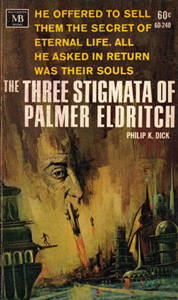“The Three Stigmata of Palmer Eldritch” (written in 1964, published in 1965) has been described as dark and brutal and haunting, but I think that’s more from the perspective of someone who is devoted to a single modern religion, particularly Christianity. To an atheist or a scholar of comparative religions, it’s a fascinating look at the way a higher being might enter humanity’s sphere, and what it might do once it got here.
Sci-fi meets supernatural
Deservedly cited as one of Philip K. Dick’s best and most important novels, “Three Stigmata” blends the inventive SF ideas that mark the first half of his career with the supernatural themes that increasingly mark the second half.
Also making it a transitional novel: It has a steadily moving (if not always forward-moving) narrative, more like his early books, but his main characters – Barney Meyerson and his boss, Leo Bulero – spend more time thinking about their strange situations than his earlier protagonists do.

“The Three Stigmata of Palmer Eldritch” (1965)
Author: Philip K. Dick
Composition year: 1964
Genre: Science fiction
Setting: New York City, future of 2016
It’s equal parts story and think piece, and this is a natural choice given the subject. The events and situations lead Barney, Leo and the reader to think about big spiritual questions. Palmer Eldritch is both a mystery and, eventually, a corporate magnate.
The mystery is juicy: He has been outside the solar system for 10 years, presumably visiting the Proxima system, and he has crash-landed on Pluto upon his return. Is this person really Eldritch? If so, what has he learned on his journey? And if he’s not Eldritch, who is he?
Corporate battle
More mundanely, Eldritch (or the faux Eldritch) leads a large corporation that is looking to market Chew-Z, a hallucinogenic drug that he hopes will dethrone Can-D’s monopoly. I suspect Eldritch’s status as a shady corporatist is why “The Strain” TV series used the name “Eldritch Palmer” for its own shady corporatist, who is also of German background and who associates with vampires. PKD’s Eldritch isn’t strictly a vampire, but he is supposedly immortal and he “feeds” off of others to achieve that.
Leo and Barney work for Can-D’s parent company, Perky Pat Layouts, which has a standing deal with the corrupt United Nations to look the other way because the drug is technically illegal. As sneak-previewed in the short story “The Days of Perky Pat” (1963), depressed colonists on Mars and other planets and moons communally imbibe Can-D while sitting around a Perky Pat diorama (a game board version of “The Sims”), which gives them inspiration for their avatars and objects within the alternate reality in their heads.
At first blush, “Three Stigmata” dodges the bad side effects of drug trips whereas “A Scanner Darkly” (1977) would later portray the harsh consequences of drug abuse. Indeed, in pitching Chew-Z, Eldritch contends that it provides eternal life with no hidden cost (so if Eldritch isn’t himself a god, he is certainly doling out godlike promises).

And as Leo finds out, Eldritch isn’t lying. When you imbibe Chew-Z, you go into an imagined world of your creation, you spend as much time there as the drug’s effects allow, and then you wake up in reality with only a split-second having passed and no negative physical effects. (Can-D, on the other hand, allows real time to pass and causes headaches.)
But one could argue that “Three Stigmata” is actually portraying the most extreme drug-trip consequences one can imagine: the end of the human race as anything other than “Matrix”-like pod-dreamers. In addition to dominating the market among depressed colonists, Eldritch thinks Chew-Z could be a hit on Earth too.
PKD tiptoes into cli-fi
In a rare example of PKD directly tackling climate change, New York City of this future 2016 is 170 degrees at noon. The infrastructure has adjusted: Everything is shielded, and the most valuable properties – and most expensive conapts — are underground. Still, it’s not ideal to live on a planet where the outdoors are unbearable (except for the beaches of Antarctica, where Leo can afford to vacation). And given the novel’s religious themes, the notion of Earth as Hell is no accident.
Whether or not he’s a literal god, Eldritch would be a functional god if Chew-Z gains a monopoly. Of course, that’s only if he too is immortal, and that’s the brilliance of PKD’s writing here. Another idea common to popular religions – and also to philosophical thought about god and the science behind the universe’s existence – is that God exists outside of time.
Extreme Chew-Z users/abusers find themselves jumping through time. Here a reader is well-served to have a grounding in PKD’s beliefs about the nature of reality — that reality might not be real, that there might be multiple equally valid realities, that each person might create their own reality, that all points in time might exist simultaneously, and so forth.
PKD often tricks readers into thinking his worlds hold together more than they really do. We are distracted by the story and ideas and humor. What puts “Three Stigmata” in an elite class among his catalog is that everything he presents here holds together with its own internal logic (even though it’s not easy to summarize this book in a nutshell).
And I suspect that’s where “Three Stigmata’s” charges of being a challenging novel come in. It’s not hard to read; it’s hard to deal with what PKD is saying. Tapping into the spiritual notion that maybe God exists outside of time and space as we commonly know it, PKD tells a robust, convincing story about a god (or near-god) who has god powers (or godlike powers).
PKD tones down the humor
It’s perhaps scary to religious people because it’s such a sharply drawn alternative story, and to all readers for presenting creepy scenarios, such as the idea of being stuck forever in a fake world – as happens to Leo before Eldritch frees him.
Furthermore, PKD tones down the humor (although there certainly is some, including the regular mispronunciation of the protagonists’ names) and his obsession with breasts (he manages to introduce Anne, a fellow Mars colonist of Barney’s, without dwelling on her looks). He instead uses that space to build up a foreboding mood.
About halfway through the book, characters start to see Eldritch in the flesh. He is recognizable by his titular traits: a mechanical arm, a mouth full of metal teeth, and cybernetic eyes. One could go down a whole ’nother path about how the melding of human and robot is inherently creepy – something that also preoccupied George Lucas in his early “Star Wars” drafts, notably when inventing Darth Vader – although this point of view was more common in old SF than it is today.
But there’s little doubt that PKD is upping the chill factor by suggesting that the god of humanity isn’t human (or the template for humans), but rather a “creature” that has lost some of its humanity.
The book is a fascinating philosophical dive even if one isn’t looking for a religion of their own, but if someone is in their spiritual-search phase, I can see them saying: “Yes, if a god comes into our lives, this is how it will be.” In that sense, “The Three Stigmata of Palmer Eldritch” is a work of biblical proportions.

